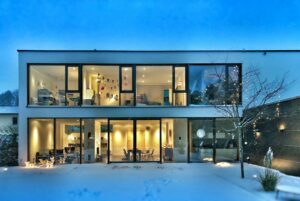TL;DR:
– Discover the essence of a Green Living Home: eco-friendly sanctuaries
– Benefits include cost savings, reduced environmental impact, and enhanced well-being
– Key features encompass energy efficiency, sustainable materials, water conservation, and indoor air quality
– Learn about energy-efficient design strategies like solar panels and smart home tech
– Embrace sustainable materials, passive design, and green roofs for construction
– Explore water conservation through fixtures, rainwater harvesting, and xeriscapes
– Ensure indoor air quality with natural ventilation, low-VOC materials, and indoor plants
– Transition to a Green Living Home for a more sustainable and healthy lifestyle.
Introduction
Welcome to the realm of sustainable living, where innovation and eco-consciousness converge to shape the homes of tomorrow. In this blog post, we dive into the realm of the ‘Green Living Home’, exploring five groundbreaking ways to craft an eco-friendly sanctuary that not only nurtures the planet but also enriches our lives. As a seasoned advocate for futuristic homes and sustainable living, I am excited to unravel the secrets of harmonizing nature and technology in pursuit of a greener, more sustainable future. Join me on this journey as we explore the unparalleled possibilities of designing a home that mirrors our commitment to a thriving planet.
What is a Green Living Home?
In today’s age of environmental awareness, green living homes have gained significant attention for their sustainable and eco-friendly features. A green living home is designed to minimize its environmental impact while maximizing energy efficiency and resource conservation. These homes are not only beneficial for the planet but also offer numerous advantages for homeowners looking to reduce their carbon footprint and lower their utility bills.
Benefits of a Green Living Home
– Lower energy costs over time
– Reduced water consumption
– Improved indoor air quality
– Increased property value
– Contribution to a greener environment
Key Features of a Green Living Home
– Energy-efficient appliances and lighting
– Solar panels for renewable energy
– Sustainable building materials
– Water-saving fixtures and systems
– Smart home technology for energy management
How to Transition to a Green Living Home
1. Conduct an energy audit to identify areas for improvement.
2. Invest in energy-efficient appliances and lighting.
3. Consider installing solar panels or other renewable energy sources.
4. Upgrade to water-saving fixtures and implement rainwater harvesting systems.
5. Explore sustainable building materials for renovations or new construction projects.
By embracing the concept of green living homes, individuals can make a positive impact on the environment while enjoying the benefits of a sustainable and energy-efficient lifestyle.
Energy-Efficient Design Strategies
Curious about how you can make your home more energy-efficient while still enjoying modern comforts? Let’s explore some innovative design strategies that can transform your space into a green living oasis.
Utilizing Solar Panels
Harnessing the power of the sun, solar panels are a game-changer in sustainable living. By installing solar panels on your roof, you can generate your own clean energy and reduce your reliance on the grid. Not only does this contribute to lower energy bills, but it also helps to lower your carbon footprint.
Incorporating Energy-Efficient Appliances
Say goodbye to energy-guzzling appliances and hello to their eco-friendly counterparts! Opting for energy-efficient appliances not only saves you money in the long run but also reduces your energy consumption. Look for appliances with the Energy Star label to ensure maximum efficiency.
Implementing Smart Home Technology
Embrace the future with smart home technology that allows you to control your home’s energy usage with ease. From programmable thermostats to smart lighting systems, these innovative solutions help optimize your energy consumption and enhance your overall living experience.
By integrating these energy-efficient design strategies into your green living home, you can create a sustainable and eco-friendly living environment that benefits both you and the planet.
Sustainable Materials and Construction Techniques
When building a green living home, the choice of materials and construction techniques plays a crucial role in ensuring sustainability. By incorporating sustainable practices from the ground up, you can create a home that is not only environmentally friendly but also durable and efficient.
Using Recycled and Reclaimed Materials
– Utilizing recycled materials such as reclaimed wood, salvaged bricks, or recycled glass can significantly reduce the environmental impact of your construction.
– By giving new life to these materials, you can minimize waste and lower the carbon footprint of your home.
– Incorporating recycled materials can also add a unique and rustic charm to your living space.
Implementing Passive Design Strategies
– Passive design techniques focus on maximizing natural resources like sunlight and ventilation to reduce the need for artificial heating and cooling.
– Features such as strategic window placement, thermal mass, and insulation can enhance the energy efficiency of your home.
– By harnessing the power of passive design, you can create a comfortable living environment while lowering energy consumption.
Green Roof and Wall Systems
– Green roofs and walls offer a sustainable solution to improve insulation, reduce stormwater runoff, and create green spaces in urban environments.
– Planting vegetation on rooftops and walls can help mitigate the heat island effect and improve air quality.
– Green roof and wall systems not only provide environmental benefits but also enhance the aesthetic appeal of your home.
Water Conservation Methods
Water conservation is becoming a critical feature in most green living homes. Reducing water wastage has numerous environmental benefits and keeps utility bills low. There are several innovative strategies that homeowners can adopt as means of preserving water.
Installing Water-Efficient Fixtures
Switching to water-efficient fixtures is a practical and affordable water conservation method. Low-flow faucets, showerheads, and dual-flush toilets optimize water usage without compromising on performance. A low-flow showerhead, for instance, can save thousands of gallons of water each year simply by reducing the water flow during showers.
Implementing Rainwater Harvesting Systems
Rainwater Harvesting Systems can be an excellent addition to green living homes. By collecting and storing rainwater, it can be repurposed for non-drinking uses like watering plants, washing cars, or cleaning the house. Not only does it decrease the demand on municipal water supplies, but it also lowers your water bill.
Designing Xeriscapes for Outdoor Spaces
Xeriscaping refers to landscaping designed specifically for areas that require minimal water use. It involves selecting plants that can thrive in local climatic conditions and are drought-resistant. Xeriscapes not only save water but also reduce the need for fertilizers, pesticides and minimize yard waste. Get creative with your outdoor spaces while contributing positively to water conservation.
Indoor Air Quality and Health Considerations
Indoor air quality plays a crucial role in our overall well-being, especially in our homes where we spend a significant amount of time. A green living home focuses on creating a healthy indoor environment that promotes wellness and comfort while reducing the impact on the planet. Let’s explore some key considerations for enhancing indoor air quality and health within your sustainable living space.
Incorporating Natural Ventilation Systems
– Open windows strategically to allow fresh air circulation.
– Use exhaust fans in kitchens and bathrooms to remove pollutants.
– Install a whole-house ventilation system for continuous airflow.
Choosing Low-VOC Paints and Floorings
– Opt for paint and flooring materials with low volatile organic compounds (VOCs).
– Consider natural finishes like clay plaster, lime wash, or cork flooring.
– These choices minimize off-gassing and promote healthier indoor air quality.
Implementing Indoor Plants for Air Purification
– Select air-purifying plants like peace lilies, spider plants, or snake plants.
– Indoor plants can help remove toxins and improve oxygen levels.
– Create a green oasis indoors for both aesthetic appeal and cleaner air.
By proactively addressing indoor air quality through natural ventilation, low-VOC materials, and indoor plants, you can create a healthier living environment in your green home. These simple yet effective strategies contribute to a sustainable lifestyle that prioritizes both your health and the planet.
Next up, we will explore the final section detailing the impact of green living on our communities and the future of sustainable homes.
Conclusion:
In the pursuit of a Green Living Home, the article has showcased innovative ways to transform your sanctuary into an eco-friendly haven. From embracing sustainable materials to integrating smart technologies, the path to a greener lifestyle is paved with creativity and purpose. By implementing these futuristic ideas, you can not only reduce your carbon footprint but also create a harmonious space that resonates with nature. Let your Green Living Home be a beacon of sustainability, inspiring others to embark on their journey towards a more eco-conscious lifestyle. Explore more tips and insights on green living homes to enrich your sustainable living experience.










